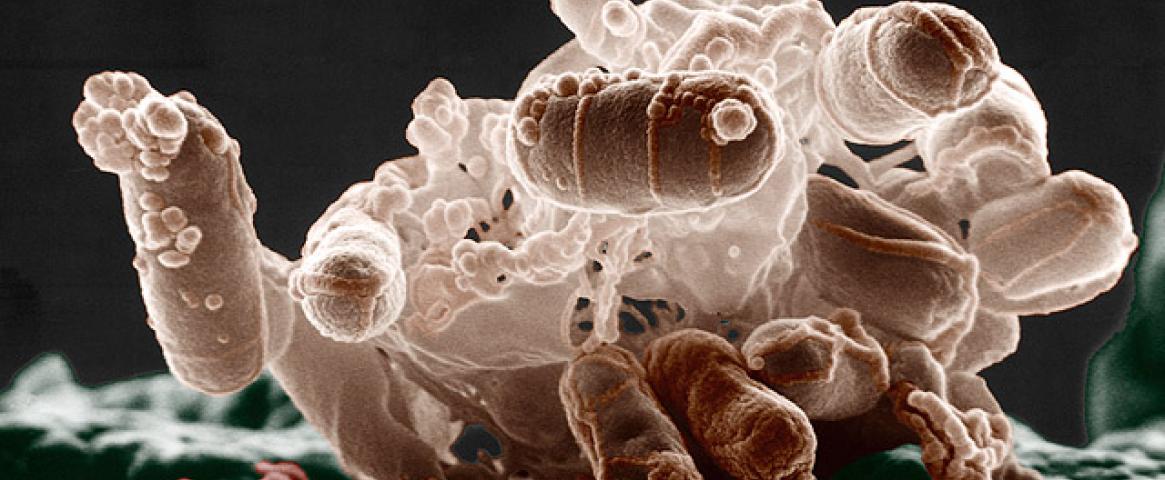By Francesco Zangari
Ruthlessly cutting a swath through an enemy horde is an asset for a warrior. But there is a danger in being too effective: kill too many of your foes, and you may find yourself trapped behind mountains of their fallen bodies.
While unlikely in human combat, this is a plight often faced by bacteria. Now recent findings published in PLOS Biology reveal certain species are not only able to dispatch their rivals but can make their fallen bodies disappear. These results hold promise for human digestive health, suggesting gut bacteria can be given the tools necessary to dominate the microbial battlefield.
Bacterial warfare doesn’t just happen in the gut. It occurs everywhere in the natural world across various microbial species. A vast arsenal of weaponry has evolved to give different strains the edge, but among the most effective is the type VI secretion system (T6SS), a spear-gun-like dart that allows for poisons to be injected directly into rivals.
T6SS allows bacterial species to poison competitors rapidly with precision. However, they often fall victim to their own success: encircled by their victims, they can become trapped and unable to advance, a phenomenon termed the corpse barrier effect.
In their new paper, William Smith at Oxford University and Andrea Vettiger, now at Harvard Medical School, propose a surprising mechanism that trapped bacteria use to escape. In a computer model built to simulate bacterial competition, their analysis revealed that the corpse barrier effect was overcome when bacteria were allowed to dissolve competitors through the injection of a potent toxin.
The next step was to move out of the practice arena and test this new mechanism on the bacterial battlefield. Experiments were performed where one strain of bacteria engineered with a dissolving mechanism was allowed to surround a non-dissolving strain. The researchers saw only bacteria that dissolved their competitors could fully clear the battlefield and travel freely across it.
“The results were encouraging” says Vettiger. “It was almost scary at times how well the models and experiments aligned”. Toxins of the kind used in the experiment are common across multiple species of bacteria, strongly suggesting they evolved for this purpose.
Stefan Pukatzki at the University of Colorado, who wasn’t involved in the study, believes Smith and Vettiger’s work represents a significant advance in our picture of bacterial warfare. “They really took care of a conceptual issue that has been around the field for a while,” he says.
This reimagining of the bacterial battlefield is likely to have consequences on the human scale as well. Our digestive systems are full of trillions of bacteria, existing in a complex ecosystem known as the gut microbiome. Keeping this microbiome balanced is crucial for maintaining good health.
This delicate equilibrium is easy to disrupt. Infection and even subsequent antibiotic use can change one’s microbiome so dramatically that a full recovery is unlikely, says Pukatzki. Often these changes promote diseases like autoimmune disorders such as Lupus and Crohn’s disease.
While many current treatments exist for restoring microbiomes, studies cast doubt on their effectiveness. The most common form is the ingestion of probiotic or “good” bacteria designed to restore the microbiome’s balance. However, the competitive landscape in the gut makes it difficult for them to survive. As a result, a long-standing goal is to engineer probiotic bacteria capable of dissolving harmful microorganisms and restoring the microbiome to a healthy state.
The hidden powers of T6SS could be just the ticket. In fact, says Melanie Blokesch at the École polytechnique fédérale de Lausanne, “you could combine several toxins that are delivered at once”. This could further improve effectiveness, limiting the impacts of bacterial resistance to a particular toxin.
Once developed, the goal is to use minimally invasive techniques to deliver these dissolving bacteria directly into the gut, whether in the form of a capsule or another ingestible medium. Parachuting these bacterial warriors into our bodies could allow us to regain control of the microbiome and restore its health, by having them fight on our behalf.
“I don't think this is science fiction”, says Pukatzki. “We will get there.”
Francesco Zangari is a Ph.D. researcher at the University of Toronto in the Department of Molecular Genetics. He is a Toronto-based writer covering science and business news stories. He has contributed to the Varsity, the University of Toronto's student newspaper of record and Canada's largest student newspaper. He has also written for Sinai Health Foundation and Massive Science. Follow him on Twitter @franthewriter1.
This story was produced as part of NASW's David Perlman Summer Mentoring Program, which was launched in 2020 by our Education Committee. Zangari was mentored by Gilead Amit.





